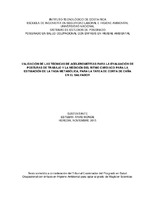Mostrar el registro sencillo del ítem
Validación de las Técnicas de Acelerometrías para la Evaluación de Posturas de Trabajo y la medición del Ritmo Cardiaco para la Estimación de la Tasa Metabólica, para la tarea de Corta de Caña en el Salvador
| dc.contributor.advisor | Crowe, Jennifer. | es |
| dc.contributor.author | Arias-Monge, Esteban | |
| dc.date.accessioned | 2016-11-17T20:52:31Z | |
| dc.date.available | 2016-11-17T20:52:31Z | |
| dc.date.issued | 2015 | |
| dc.identifier.uri | https://hdl.handle.net/2238/6733 | |
| dc.description | Proyecto de Graduación (Magíster Scientiae en Salud Ocupacional con énfasis en Higiene Ambiental) Instituto Tecnológico de Costa Rica, Escuela de Ingeniería en Seguridad Laboral e Higiene Ambiental, 2015. | es |
| dc.description.abstract | In Central America, manual sugarcane cutting is exhausting work known to have a high metabolic load and to be associated with many occupational hazards including insect bites, snake bites, inhalation of particulate matter, pesticide exposure, physical violence and eye injuries resulting from a number of factors including sudden and repetitive body movements, intense work pace and extreme physical exertion. The main objective of this research was to evaluate the feasibility of acelerometer methodologies for upper limb postures and the calculation of metabolic rate from heartrate as an assessment of manual cane cutting during the pilot phase of the “Worker Health and Efficiency” (WE) program in El Salvador. This was done through 1) a description of relevant working conditions for the use of assessment methodologies or designing experiments in cane cutters during the WE program; 2) analysis of accelerometers to determine positions of the upper extremity work of cane cutters and 3) evaluation of a methodology for determining metabolic rate from the heart rate measurement. The WE Program includes, among other components: water supply through use of water “backpacks”, programed breaks in the shade during the shift, supervised food (lunch) and replacing the cutting technique with a methodology used in Australia. A total of 52 people were observed, of which 12 were evaluated for working postures. Of these, 8 were part of the posture sample together with 42 other workers. A description of working conditions included clothing, footwear, personal protective equipment, transport, rest, water, and land conditions. Given the high loss of accelerometer data, it was not possible to complete the analysis of postures. However, the data obtained is reported to guide the next steps of the project. According to data obtained, personal factors (examples: fitness, productivity) or environmental (examples: soil type, growth parameters cane, high temperature) may be affecting the metabolic rate of workers, possibly explaining or producing considerable variation in metabolic rates in the task of cutting sugarcane. The qualitative description of working conditions was insufficient to create exposure indicators. Heartrate measurements taken with pulsometers for estimating metabolic rate may be an appropriate technique given the working conditions. Finally, specific changes are recommended for experimental design and data collection protocol for the estimation of working postures using the accelerometer methodology. | es |
| dc.description.sponsorship | Instituto Tecnológico de Costa Rica. | es |
| dc.language.iso | spa | es |
| dc.publisher | Instituto Tecnológico de Costa Rica | es |
| dc.rights | acceso abierto | es |
| dc.subject | Riesgo | es |
| dc.subject | Pulsímetro | es |
| dc.subject | Acelerómetro | es |
| dc.subject | Zafra de la caña de azúcar | es |
| dc.subject | Caña de azúcar | es |
| dc.subject | Corte de caña de azúcar | es |
| dc.title | Validación de las Técnicas de Acelerometrías para la Evaluación de Posturas de Trabajo y la medición del Ritmo Cardiaco para la Estimación de la Tasa Metabólica, para la tarea de Corta de Caña en el Salvador | es |
| dc.type | tesis de maestría | es |


